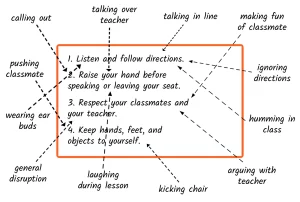
There is a simple, ten-minute exercise you can do this summer that will all but guarantee better consistency next school year.
All it takes is a piece of paper and something to write with.
I’ve described this particular exercise before. However, it begs repeating because it’s so effective.
Here’s how it works:
First, draw a rectangle in the center of your paper.

Next, list your classroom rules inside the rectangle.

Third, outside of the rectangle write down every unwanted behavior you witnessed during the past year.

Finally, draw a line from each misbehavior to the rule it breaks.
There will be instances where the misbehavior breaks more than one rule. This is fine and perfectly normal. In this case, just pick one rule.
The reason why the exercise is so effective is twofold.
First, it ensures that your classroom rules are able to cover every misbehavior you’re likely to encounter. If you can’t clearly and immediately draw a line from a misbehavior to a rule, then you have to add a new rule.
Second, by reviewing your drawing this summer—and thus knowing exactly what misbehavior breaks which rule—you’ll be able to enforce consequences without hesitation, uncertainty, or fear.
The result is better consistency.
Now, it’s important to mention that the rules we recommend here at SCM for elementary and lower middle school are proven to cover every possible misbehavior.
However, it’s still critical that you’re 100 percent clear which rule or rules each misbehavior breaks.
If you’re a high school teacher, the only difference is that you’re likely to have considerably more rules—as explained in the SCM high school plan.—as well as a different system of consequences.
PS – I’m taking next week off for the July 4th holiday but will be back with a new article on July 12th.
Also, if you haven’t done so already, please join us. It’s free! Click here and begin receiving classroom management articles like this one in your email box every week.


Thank you for your consistently great tips.
I love this.
It emphasizes intention and accountability.
The visual puzzle gets mapped into your brain for easy access by the pencil-paper trick work.
Thank you. 🙂
Thanks so much Michael! I’m already excited for next year to be honest. One question, is it expected (or even possible) for third graders to be completely quiet during class time? I would like them to be quiet and focused during class time, but I see them about 5 hours a day, and complete silence seems unrealistic… Any article about this?
I teach middle school, which, let’s face it, is just an extension of 3rd grade. I see each of my classes for an hour. If my expectation was for them to be quiet and focused for a full hour, I would be disappointed every day! They need time for a stretch, a brain break, and even to chat with a friend for a couple of minutes. Our classwork does include quiet work on their own, but also comparing with a partner, having one student come up and lead a review of the answers to an assignment, small group work, learning games (such as bingo), etc. If you use screen time in class (I’m not sure I would with third grade, but I don’t know), you can use the google slides extension Peardeck, which allows each student to contribute a drawing or sentence or answer to a poll (etc.) on their chromebook and then you can project each answer on the screen (the projections are anonymous but you can see what each student wrote).
I am a retired teacher (35+years in early years) but now I substitute almost full time. I read your articles every week. Any articles for substitute teachers in particular?
Thanks, I substitute at one school as a permanent substitute. I’ve subbed for every teacher at the school, and it’s challenging to adapt to different classrooms with different management methods. I’d love to hear his thoughts on making my job more effective.
I am a substitute teacher after 40 years of working in various aspects of education. I was a teacher at Head Start for 20 years. I got my BS Degrree when I was in my 30-40i retired as a Family Advocate with Head Start. I now substitute at High School l I love it! And I enjoy your articles on behaviors and other ideas. Thank you because teachers don’t consider substitute as anything but glorified baby sitters. Thank you for your time.
I have tried the classroom management plan the last two years in first grade. Unfortunately, I’ve not successful YET because I have 30 kids and at least five (this year nine) with ADHD/autism. I cannot seem to manage those behaviors. The biggest issue is they can’t sit still/stay in one spot.
Any advice at all would be greatly appreciated.
Not sure why ADHD would change anything. About 1/3 of any class has it as either diagnosed or undiagnosed. It’s so typical, I’m beginning to think they just evolved from Hunters instead of Gatherers.
Autism is a spectrum, so I’m not sure the level of special needs that is (or non at all). But I can speak to ADD. They will be your best, most focused students if you can create a hook that captures their attention and gets them on the edge of their seats. Then just teach the heck out of it with stories, epic meaning, and relevance.
If you believe in your heart that ADHD students are “hard”, then they will be. In fact, in an average class, I’m guessing nearly half will have at least something to do with ADD, autism, colorblindness, dyslexia, dyscalculia, ODD, etc. It’s normal. Nothing new, we just have names for it now. In most of the places I taught, a “neurotypical” kid was the exception. The good news is that you teach to them, and the typical kid will also succeed.
I hear you Lisa and had a year like this last year teaching kindergarten. It was something no one, nor myself had ever seen before. I felt I needed more special education training to help, but was unable to find. Our school was blessed with some professional learning and they also, observed and gave guidance to teachers. My hope was so high that she would have answers…. But she even said you’re doing all the things! It was extremely trying and frustrating. In the end the thing that helped the most was the relationship built with each student and in turn their parents. Showing the students that you care deeply goes farther than I could’ve ever imagined. Consistency with rules always, but yes these kids even at end of year were just still unable to control impulses. You’re not alone, a bad teacher or going crazy… I think something will come to light and all the teachers who have endured what you’re describing will think, “I told you so!!”, when everyone else figures it out. Waiting for the day!
There are many times throughout the day when students must NOT talk. Here are a few: when the teacher is presenting a lesson/giving instructions, when students are completing a test, when students are walking in the hallway as a group to go to “specials” (gym, music or art), when students are reading silently, and when students are completing an assignment. Of course, there are other times when students must not talk and the teacher should make his/her own determination. During these times, I tell my students that there should be no talking. But, rather than saying, “no talking,” I say to my students, “This is done without talking.” In my experience, this phraseology seems to make a stronger impact on students by causing them to form a mental picture of themselves doing “x” without talking.
I am a substitute teacher and I say: “This will be a silent and independent activity.” Another thing I do, since many kids want to talk during transitions, is to harness that tendency in my favor. I give them explicit permission. I say: “You may talk as you get set up for this activity, and then we go to silent mode. I’m setting my timer for two minutes.” This way I show them that it was MY decision to allow it, and not THEIR decision to do it. I think this is disarming because it is unusual for a teacher to tell them that they can talk! They appreciate that I gave them the opportunity to chat, and we all know how long it will last.
Thank you for sharing this!
Great info! I am interested in knowing the consequences for breaking the above rules.
Like it.
I have been following your articles for a long time but I don’t remember seeing this before! I have it bookmarked for those first days in August. Thank you!
I very much enjoy your articles but would like to see a list of your rccomended rules
I am an Art teacher in a small private school. I have 30 to 45 minutes a week for each
k-5 to 5th grades. I have a hard time coming up with appropriate consequences. After the verbal warning then what? I can’t give them silent lunch etc like the classroom teacher. Struggling on this one.
Hi Sharon,
I recommend the orange book to your right.